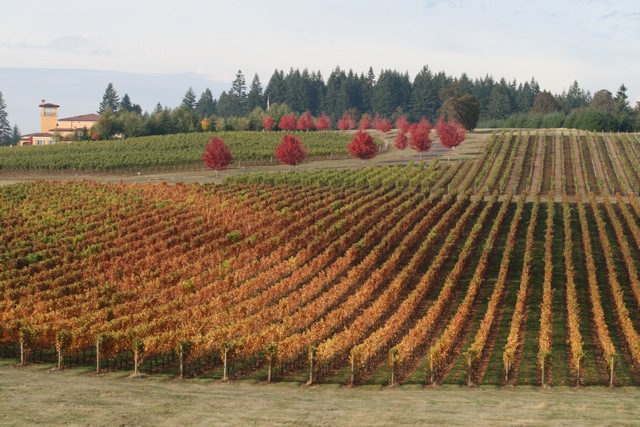The sense of place extends beyond just the winemaking process. It should also extend to the wine consumption process.
 The word terroir describes the many unique aspects of a location that influence a wine specific to a region, or as Jancis Robinson describes in the Oxford Companion to Wine, “the total natural environment of any viticultural site.” It is argued that aspects like soil, topography and climate, are all components that affect terroir, and ultimately of the unique taste of the wine. Terroir reflects place, therefore place matters.
The word terroir describes the many unique aspects of a location that influence a wine specific to a region, or as Jancis Robinson describes in the Oxford Companion to Wine, “the total natural environment of any viticultural site.” It is argued that aspects like soil, topography and climate, are all components that affect terroir, and ultimately of the unique taste of the wine. Terroir reflects place, therefore place matters.
So, if place has a profound impact on the development and production of wine; what effect does place, or WHERE you drink a wine, have on the taste of it? Would the exact wine taste the same if you were to drink it at cellar temperature at a fine dining establishment as opposed to drinking it poolside in a tropical resort on vacation?
I think about that question as I reflect on one of my worst experiences with wine. It happened on a recent trip to Hawaii where I brought with me a mixed case from home to share with friends while on vacation. Wines I knew well and loved, yet none of them ended up tasting right throughout the entire week. The setting was seemingly perfect. The company involved some of my closest friends. But the wines were all wrong. So, what was wrong with the wine I brought?
Where you drink a wine matters
This led to me thinking about “the other side of terroir.” By thinking about terroir beyond the winemaking process, and extending it throughout the consumption process, we could make better decisions on where we open a particular bottle thus giving that wine (and your experience of it) its very best sense of place.
Three major environmental factors related to your impression of a wine should be considered before you open up your next bottle. Though these are not the only factors, they are certainly the ones that come up the most frequently.
Physical Setting/Location
The physical setting of where you drink a wine can have a strong impact on the taste of it—or, more importantly, your impression of it.
Traveling to a wine region and drinking wines made at the source, or at a local restaurant, can really enhance your impression of a wine. Erica Landon, sommelier and wine educator for the International Sommelier Guild, reflects a sentiment I often hear: “When traveling in Europe you often eat at small local restaurants or bistros and have the house wine. With the architecture, culture and language surrounding you, the wine seems to blossom, always remembered as some fantastic hidden jewel of the town. But if you brought some home with you and shared it with your friends, it might not be as amazing as remembered. I am convinced this phenomenon has kept Retsina in production in Greece!”
This idea of location extends to the external temperature of where you are. If you are at an outdoor event in 100+ degree heat even the best California cult Cabernet will not taste right, but if you come home after a long winter’s day, greeted by a warm fire and a home cooked meal, that same wine may be out of this world.
This scenario may seem all too familiar for those who attended the recent North American Wine Bloggers Conference in Charlottesville, Virginia. Throughout the weekend temperatures were hovering around the 100 degree mark with oppressive humidity to boot. The first evening of the conference involved an outdoor reception at Monticello where the most well received beverage of the evening was an apple cider. Admittedly, it was the most refreshing drink available next to the sparkling water.
In hot weather, consider opening wines that have a refreshing or cooling effect on you rather than opening up your best red wines as they may have the reverse effect.
The People and your Surroundings
Whom you drink wine with can also affect your impressions of it. Being surrounded by good company in the right setting can elevate the quality of a simple wine.
 However, I have often found the opposite to be the case when going to an overly crowded wine festival or busy tasting room. The larger, crowded, and unmanaged wine events can cause anxiety and frustration; I enjoy myself less there, and it carries over to any given wine.
However, I have often found the opposite to be the case when going to an overly crowded wine festival or busy tasting room. The larger, crowded, and unmanaged wine events can cause anxiety and frustration; I enjoy myself less there, and it carries over to any given wine.
So what are we supposed to do in these situations? If I am going to a festival to learn about new wines I go early to avoid large or pushy crowds. In a bustling tasting room I recommend removing yourself from the crowd for a moment. Take a walk outside with your wine, perhaps among the grapevines, and get some fresh air. Taking your time sipping the wine in quiet while removing yourself from the crowd can allow you to better focus on the wine, and less on the distractions from a crowded room. Thus you will avoid feeling anxiety and stress that can influence your perception of a wine.
This information may seem commonplace to many of us, but even wine professionals are unknowingly affected by place and the company they are with, as noted by a colleague who is a former sales rep for a prominent Oregon winery. She described to me the differences between pouring wine for buyers in two different situations. One was in the company of the owner and winemaker, while overlooking the vineyard and mountains in the background. The other involved pouring the same wine in the corner of a dark restaurant, for a distracted buyer with a line of eager sales representatives waiting their turn. “It was always easier to sell a case of reserve wine in the vineyard than on the road. The ambience and the personal attention always helped even though the wine was the same.”
Whether in one-on-one time with the winemaker or stuffed in the middle of wine consumers during a crowded festival, the people that surround you can influence your wine experience and the attention you afford the wine.
Setting, temperature, ambient surrounding, the company you are with, these are all things that add up to the capstone—your emotional temperament.
Emotional Temperament
Your emotional temperament is an important factor to consider when drinking any wine. Your mood in any setting—negative or positive, anxious or relaxed—can play a role in determining your response to a particular wine.
In a negative state of mind you are more likely to look for and point out negatives or perceived flaws in a wine. On the other hand, an exceedingly positive state of mind might make what you would normally consider an okay wine into an excellent one.
One of my most memorable wines was a 1997 St. Francis Winery Cabernet Sauvignon, Kings Ridge Vineyard Reserve, consumed the evening I got engaged to my now husband. It was a cold December evening and we were eating wild ostrich tenderloins in the kitchen in our tiny San Francisco apartment. The overall experience elevated what was already a good bottle of wine into a really great one. Was it simply the emotional aspect that made this experience? Was it the setting? Or the wine? I believe we cannot separate all of these factors as they worked together to make the overall experience.
Where you consume a wine can trigger emotional responses to what you are drinking, thus forging strong memories. Much like the effect music can have on your mood, a memorable bottle of wine can also transform you back to the very place where you first consumed the wine, who you drank it with and how much you enjoyed it, immediately improving your mood.
Being aware of this when you open a nice bottle of wine can prove to be an opportunity to transform a negative mood, allowing you to clear your mind and focus on the wine and positive memories evoked.
If we all think about the best or worst wine we have ever had I would bet that for the majority of us there is a story behind it, memories evoked, emotions that are attached that are connected to the actual place where the wine was consumed and the people we consumed it with. You cannot always separate all of those factors. Therefore all of these factors should be important in considering when and where you plan open your next bottle of wine.
Most of us can agree there are many unique aspects of a specific place that influence the making of wine specific to that region. This is how many of us are used to thinking about terroir. We could say it is simply the place where the grapes are grown that makes it special, but we know it is so much more than that. The place where we consume that bottle of champagne matters too, beyond our traditional view of terroir.
Perhaps I was careless in bringing some of my favorite wines to a hot, tropical location to consume in the heat and sunshine—perhaps it was just the wrong setting for them?
Is this a call to winemakers to make sure they are telling us where (and not) to drink their product? No. But understanding the other side of terroir when deciding what you are going to consume—and, importantly, where—could very well give that wine and your experience of its best sense of place.
 Mary Cressler is a Certified Sommelier through the Court of Master Sommeliers, a Wine Location Specialist through the Center for Wine Origins, and is the proprietor of Vindulge: Wine Education & Consulting. She conducts wine classes and events and offers consulting for individuals, restaurants, and event planners seeking a dynamic wine education event. She also writes about wine, food, and travel on her blog Vindulge. For more you can send Mary an e-mail at mary@vindulge.com.
Mary Cressler is a Certified Sommelier through the Court of Master Sommeliers, a Wine Location Specialist through the Center for Wine Origins, and is the proprietor of Vindulge: Wine Education & Consulting. She conducts wine classes and events and offers consulting for individuals, restaurants, and event planners seeking a dynamic wine education event. She also writes about wine, food, and travel on her blog Vindulge. For more you can send Mary an e-mail at mary@vindulge.com.
